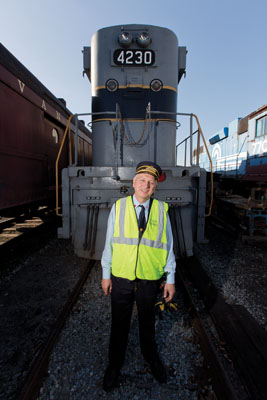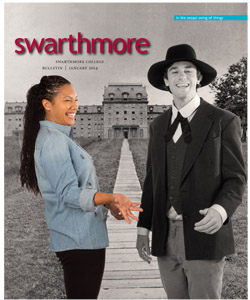VIDEO: The Ride of His Life
Physicist Frank Moscatelli has been on track with trains since boyhood

Frank Moscatelli, suited up for his scenic Sunday circuit from West Chester to Glen Mills, Pa., says his dream is to ride the rails on the Orient Express or across the United States. Photo by Laurence Kesterson
If the rumble of the rails, the hiss of the air brakes, and the shrill piping of a train whistle are music to your ears, then you have a lot in common with Frank Moscatelli.
A self-proclaimed “gears-and-pulleys kind of guy,” Moscatelli is an experimental physicist who’s taught at Swarthmore for 31 years. He’s quick to admit, “I’ve been a railroad buff for as long as I can remember.”
He loved playing with model trains as a child in Brooklyn. The family’s move to Long Island for his father’s job in the aerospace industry introduced the scientifically curious boy to the Long Island Railroad’s busy commuter trains.
But what really packed a powerful wallop was his eighth-grade class trip to Washington, D.C. Riding behind iconic, megahorsepowered locomotives from New York’s Penn Station to Philadelphia to D.C., he recalls little about the soaring marble sweep of the Capitol but all about the vintage cars he encountered and the world he glimpsed through those train windows. He was hooked.
Unlike air travel, where you’re sealed off from the outer environment, train travel offers a quiver, clatter, and creak as your car rattles and rocks along, the blast of a whistle as you pass through a crossing, the scrape of wheels on steel. Through your rectangular window you see not blank sky but four navy-blue silos, a white wooden barn with its paint chipping away, a dun-brown cornfield, with half its stalks standing, half consumed by the maw of the combine.
Train travel is an experience Americans have enjoyed since the late 1820s. Now Moscatelli has achieved something rare—an equivalent to the rush a die-hard baseball fan feels as he suits up for a Yankees Fantasy Camp. Except this is no one-time dream come true. Moscatelli has progressed from guiding model trains around his parents’ dining room to directing the forward and backward movements of genuine 100-ton diesel engines pulling vintage cars and hundreds of passengers.
Nearly every Sunday, if you take the 90-minute round-trip tourist-train ride through rugged rock cuts and green and gold tunnels of trees from West Chester, Pa., to the striking red-brick Victorian station in Glen Mills, you’ll hear him hollering, “All aboard!” In his navy suit, a gold watch chain looping across his vest, his billed Pennsylvania Railroad cap emblazoned with a gold conductor badge, he cuts a striking figure. Conductor Moscatelli strolls the aisles of the 1930s-era cars of the West Chester Railroad, walkie-talkie in hand, directing the engineer and the crew when to leave the station and when to stop the train.
Come Monday, you’ll see the Edward Hicks Magill Professor of Mathematics and Natural Sciences hatless, in casual pants and short-sleeved shirt commanding a physics class in the Science Center.
While it may not be as extensive as a Ph.D. program, the training for his job captaining a train involved passing many tests on the same United States Federal Railway Administration rules that an Amtrak employee needs to master.
Moscatelli started out in 2009 as a trainman—collecting and punching tickets and escorting passengers. For the last year, he’s held the top job, the lone professor among 11 conductors, whose professions include software engineer and truck driver. They trade off conducting the 14-mile round-trip stretch of rail. The West Chester Railroad has been an independent tourist line since 1997, nine years after commuter service from Philadelphia ended.
Being a conductor, Moscatelli says, “is a position of responsibility.” His duties include reading the day’s orders, figuring out how many coaches to put on the train, tallying the number of passengers, attaching the air-brake system and testing it to make sure every wheel responds. Warming up cars on winter mornings, cleaning and decorating them—for the fall foliage tours, that means orange, leaf-shaped lights tacked above the windows—are part of the job. “It’s not all glamour,” he points out.
But the payoff makes all the behind-the-scenes work worthwhile. Once the train sets off, Moscatelli enjoys the scenery as much as the first-timers pointing their Nikons out the windows. “I’ve always loved riding trains. It’s relaxing,” he says.
And he enjoys mingling with passengers—sometimes even agreeing to dance with them—on holiday excursions with guest attractions such as Count Trackula at Halloween and Santa and the Easter bunny.
“I’m interested in bringing people together and being a source for them to learn about trains,” he says. “The teaching part is interesting and, of course, ties into my life at Swarthmore.”
But Moscatelli also enjoys being a student. “I’ve learned a lot from Larry here,” he says, pointing to a trainman. “Railroaders are also teachers.”
Some days a different trainman assists him—his wife Anne-Marie, a French professor at West Chester University. “As with any good spouse, she shares in her husband’s fetish now and then,” he says with a smile.
The Moscatellis also share a love of Manhattan, often traveling there by rail. When he retires, Frank plans to shift to the New York City Transit Museum. “They use lots of volunteers and occasionally take out vintage subway trains,” he says.
Until then, he’s delighted to split his time between a rewarding career and a fulfilling hobby. Says Moscatelli, “It’s wonderful to be able to be both a physicist and a conductor—a physicist endeavors to understand everything, while a conductor is in charge of everything. It’s a dream come true.”
 Email This Page
Email This Page